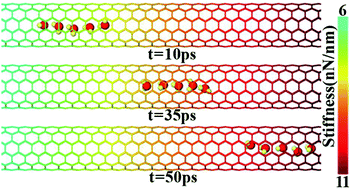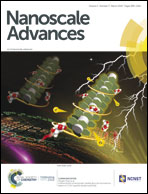Spontaneous directional motion of water molecules in single-walled carbon nanotubes with a stiffness gradient†
Abstract
Controlling water molecular motion at the nanoscale is critical for many important applications, such as water splitting to produce hydrogen and oxygen, biological and chemical cell reactions, nanofluidics, drug delivery, water treatment, etc. In this paper, we propose a new nanoscale device based on carbon nanotubes (CNTs) with a stiffness gradient to create a spontaneous directional motion of water molecules, and perform molecular dynamics simulations to analyze its transport characteristics. We find that the (6, 6) CNT possesses an optimal water transport rate. In the thinner CNTs, the water molecules are strongly confined by the CNT wall, resulting in a higher friction force; while in the thicker CNTs, the driving force is lower, and the water molecules tend to form ring-like configurations, resulting in a slower motion. For the (6, 6) CNT, water molecules tend to favor a chain-like configuration, through which the molecules are able to move synergistically along the stiffness gradient, and the transportation efficiency increases with the stiffness gradient but decreases with temperature. Both energetic and kinetic analyses are performed to elucidate this fascinating directional motion. Our work demonstrates a new strategy for controlling water molecular motion at the nanoscale without resorting to any active driving source, such as electric field, temperature or pressure difference.



 Please wait while we load your content...
Please wait while we load your content...